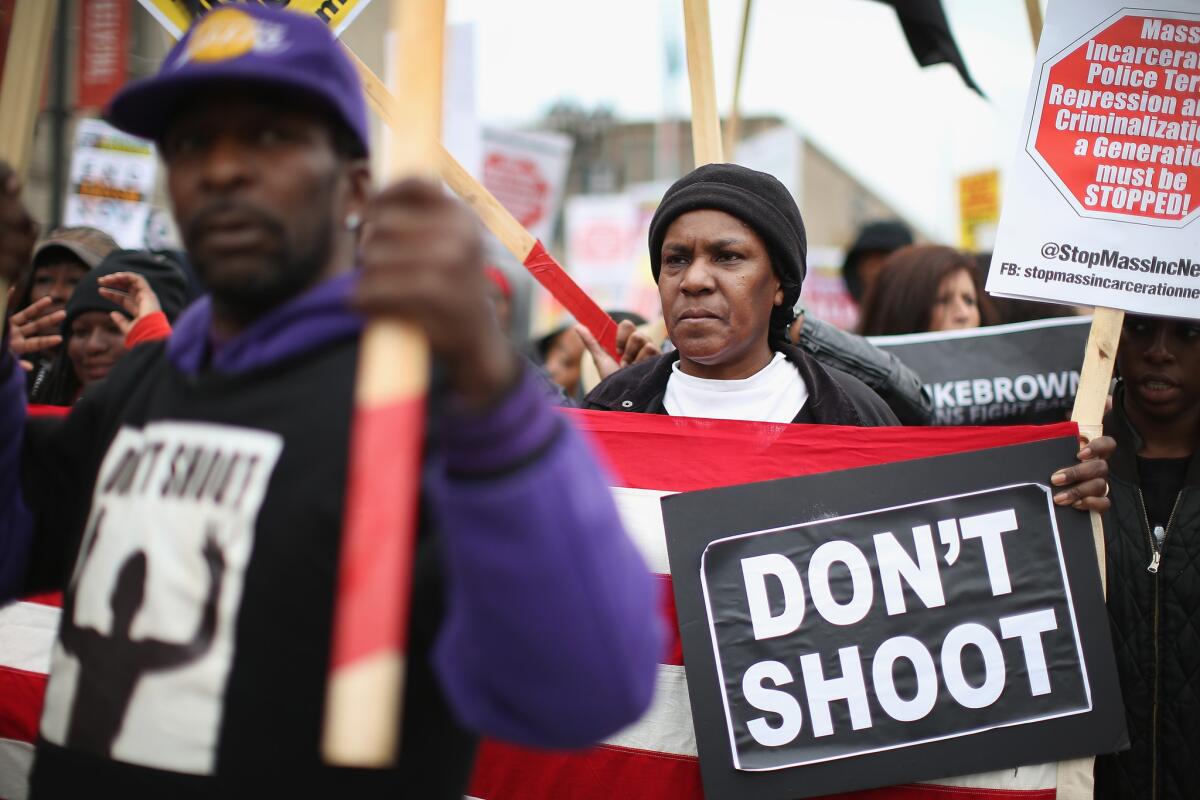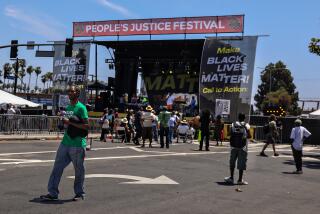St. Louis’ pride and unrest: Cardinals October vs. ‘Ferguson October’

- Share via
Reporting from Ferguson, Mo. — In October, a month in which St. Louis’ civic identity is normally dedicated to Cardinals playoff baseball, the city’s unresolved racial tensions are competing for center stage as hundreds and possibly thousands of demonstrators have gathered for a weekend of meetings and protests called “Ferguson October.”
A city’s pride now competes with a city’s grievances.
The months of unrest over the death of 18-year-old Michael Brown that have turned eastern Missouri into a hotbed of civil disobedience are no longer confined to West Florissant Avenue in the suburb of Ferguson, where Brown was shot by a white police officer on Aug. 9.
Instead, protesters have increasingly been spreading their anger across the greater St. Louis area, where racial division remains inscribed in various ways. In St. Louis an informal border exists between the city’s predominantly black north and predominantly white south, and between black residents and white political leadership.
Lines have also been drawn between the region’s fervent Cardinals fan base and passionate demonstrators calling for an end to police shootings. That division became especially explicit after a playoff game last week in which black demonstrators outside Busch Stadium were met by racist taunts from white fans such as, “We’re the ones who gave y’all the freedoms you have!” and “Africa! Africa! Africa!”
When at least several hundred demonstrators amassed in downtown St. Louis for a “Ferguson October” gathering on Saturday morning — with another Cardinals playoff game scheduled that night — it was probably one of the only areas near the stadium where most of the red clothing was not Cardinals gear.
Instead, the few red shirts worn by demonstrators had words showing their allegiance to groups such as the Urban League of Metropolitan St. Louis, the National Nurses Organizing Committee and the Chicago Teachers Union.
One demonstrator wearing a red Cardinals hat was Michael Henderson, 43, of nearby University City, who was slowly pedaling a bike in front of the crowd as it marched forward and chanted slogans. “I’m not a Cardinals fan. I won this hat at bingo,” Henderson explained. “Cardinals fans, a lot of them, are part of the problem. ... They are from that side of the fence.”
(In a statement made over stadium loudspeakers a week after Brown was killed as unrest racked Ferguson, Cardinals officials told fans that “we have all been heartbroken by a series of violent events that do not reflect who we are as a people.”)
James Page, 65, marching and chanting in the center of the crowd, was also wearing a Cardinals hat for an unusual reason.
“It is as exact a replica as I could find in the Cardinals store of the hat Mike Brown was wearing when he was killed,” said Page, a downtown resident. But he was also wearing it, he said, because he is a proud resident of the city “and proud of the Cardinals, even — I’m rooting for them all the way to the World Series at the same time I’m calling for change in our communities.”
The building sense of colliding contexts in St. Louis hit an especially ominous note when Saturday’s march ended at Kiener Plaza, where a fountain was dyed red — as it has often been during Cardinals playoff runs — and to some the water resembled blood boiling around a statue of a young man.
“I think that’s the point,” one protester observed, thinking it had been done for the rally to protest police shootings. “I’m pretty sure this is awareness month for breast cancer,” said another.
“These fountains are freaking me out,” said one of the speakers who addressed the crowd on Saturday afternoon, Montague Simmons, of the Organization for Black Struggle. “I’m thinking of the blood that soaked into the ground in Canfield,” the name of the street on which Brown was killed and of a nearby apartment complex.
Simmons said he was also disturbed given the rally’s adjacency to the Old Courthouse, a historically racially fraught site for St. Louis, where slaves were sold on the courthouse steps.
“Police terror existed well before slavery ended,” Simmons said. “They didn’t respect black lives then and they don’t respect black lives now.”
Many protesters say that real change won’t be possible until St. Louis’ white residents understand the city from their perspective. Hannah Vaughan, 24, who is white, counts herself among some of the recently awakened.
On Friday night, as a heated but peaceful crowd of more than a hundred demonstrators stared down a line of riot police outside the police station in Ferguson — with a few demonstrators unleashing invective at the stony-faced officers — Vaughan fell to her knees and prayed fervently and tearfully for peace in front of the police holding clubs.
After crouching to the ground and dirtying her forehead and her sweater on the pavement, Vaughan — from predominantly white St. Charles County on the outskirts of St. Louis — explained that she loved Jesus and that “there’s a lot of racism here. I hadn’t had to notice it because I’m white; I think I was really naive to it all.”
She added, “I don’t know how to make people care, but I wish they would. Some of my friends have had their eyes opened, but a lot just care about the Cardinals.”
More to Read
Sign up for Essential California
The most important California stories and recommendations in your inbox every morning.
You may occasionally receive promotional content from the Los Angeles Times.














